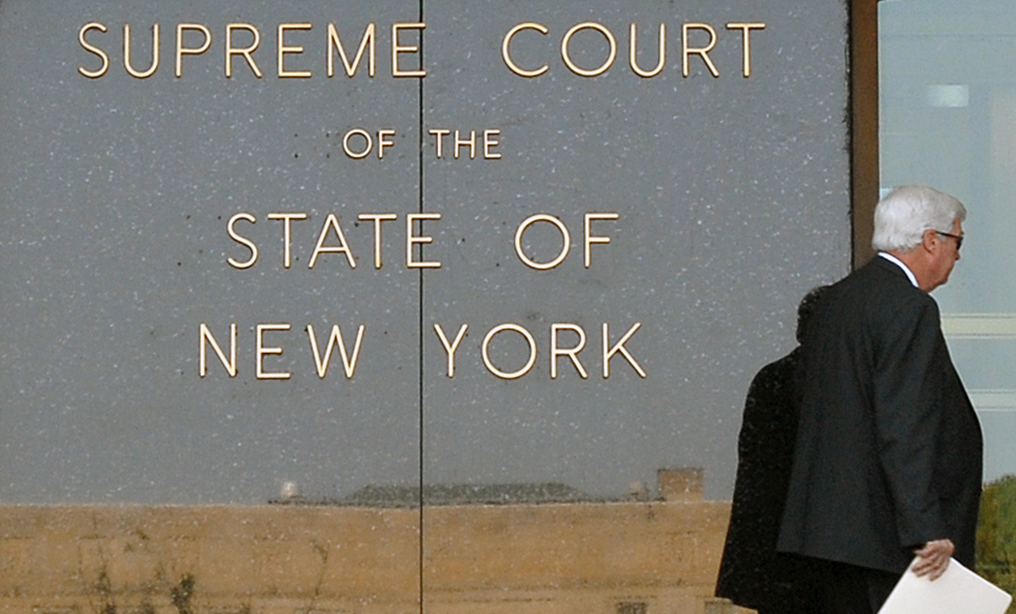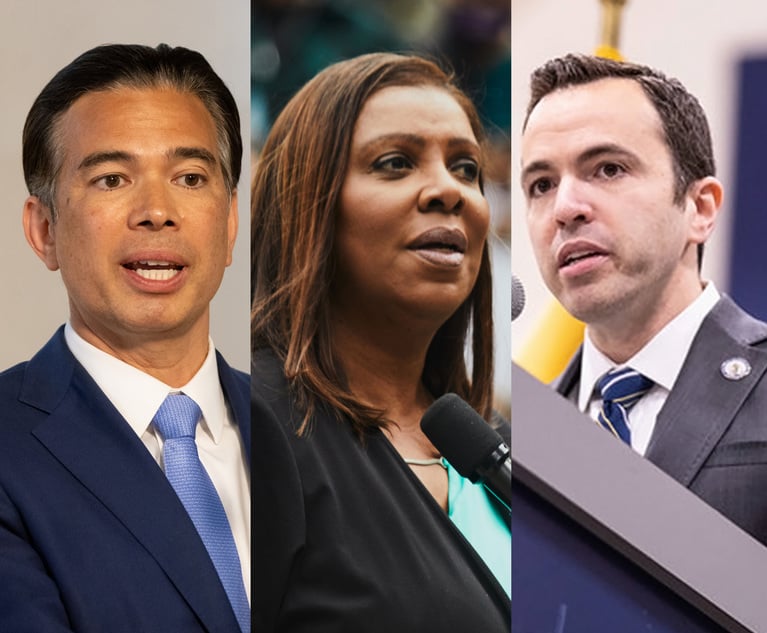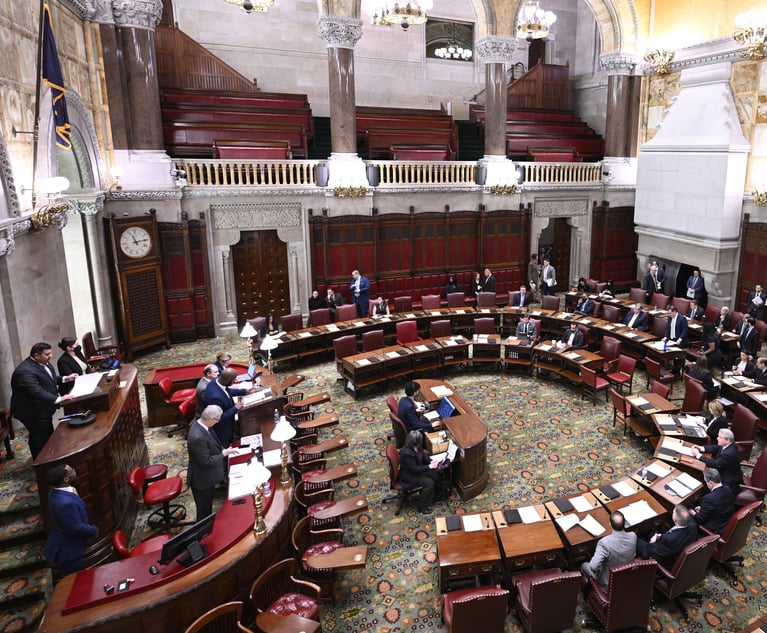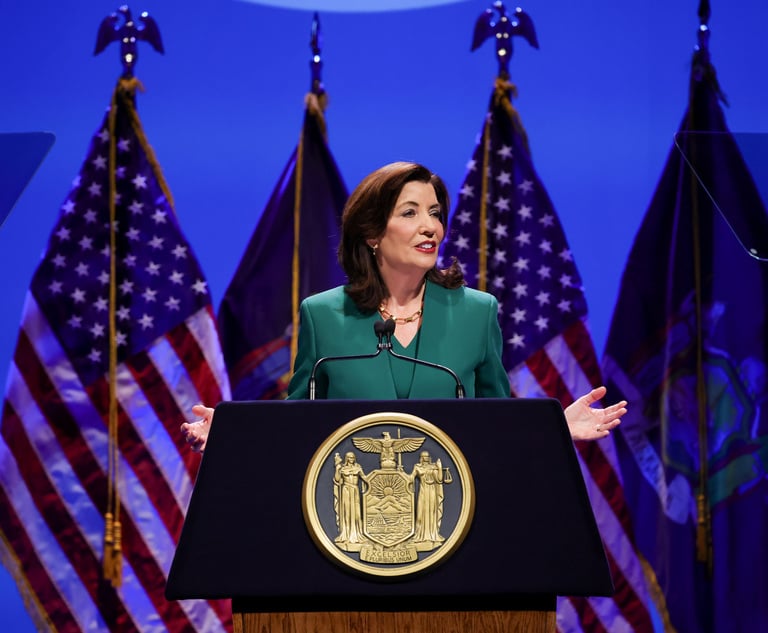NY Lawmakers Set to Hold First Hearing on DiFiore's Trial Court Reform Plan
State court officials have been waiting for the Legislature to take a hard look at the state's trial courts for decades, since former Chief Judge Judith Kaye breathed new life into the idea during her tenure.
September 27, 2019 at 05:47 PM
6 minute read
 Photo: Rick Kopstein
Photo: Rick Kopstein
For the first time in at least two decades, state lawmakers in New York are set to hold a public hearing on a proposal from state court officials to consolidate the current complex—and many say archaic—web of trial courts into a three-tier structure in order simplify the state's judicial system.
The State Senate and Assembly in New York are expected to hear testimony later this year on the proposal, lawmakers said this week after Chief Judge Janet DiFiore unveiled the plan.
"We're working with our conference leadership in confirming a date for at least one hearing, and maybe future ones in different parts of the state," said State Sen. Brad Hoylman, D-Manhattan.
Hoylman, who chairs the Judiciary Committee in his chamber, said he's optimistic that the Legislature could take the first step toward codifying the proposal during the upcoming legislative session.
"We'll have to see how the hearings go. There may be some considerations I haven't foreseen, but I have a willing partner in the Assembly and I'll speak to Senate leadership," Hoylman said. "I'm hopeful we can make significant headway on something that's stymied Albany for decades."
Assemblyman Jeffrey Dinowitz, D-Bronx, who chairs the Judiciary Committee in the lower house, said the hearing is scheduled for Nov. 13 in New York City.
He said the idea of reforming the state's trial courts is far from new. It was already widely discussed when he first took office more than two decades ago. He said he wants to hear from stakeholders before taking a position on DiFiore's plan.
"Certainly the issue of the hodgepodge system we have of all these different courts in the state is something that needs to be examined, no question about it," Dinowitz said. "I think the proposal that has been put forth certainly merits careful consideration."
State court officials have been waiting for the Legislature to take a hard look at the state's trial courts for decades, since former Chief Judge Judith Kaye breathed new life into the idea during her tenure. Her successors, including DiFiore, have continued that effort.
A spokesman for the Office of Court Administration said Friday that it is looking forward to the Legislature's public hearings on the topic and plan to have officials testify.
"We very much look forward to the public hearings and testifying in support of the initiative," said Lucian Chalfen, an OCA spokesman.
Hoylman said that, aside from state court officials, the Legislature would like to hear from other stakeholders in the debate on court reform, including those in the legal profession. The State Bar Association has historically been a major proponent of reforming the state's trial courts.
"Certainly I'd be interested in hearing from legal service providers, community groups, attorneys themselves, bar associations, and business organizations," Hoylman said. "It's really just about anyone who has to navigate the labyrinth that is New York state's trial court system."
Not all of the feedback they'll hear on DiFiore's proposal is guaranteed to be positive, Dinowitz said. He's also interested in hearing from a wide range of individuals and groups with a stake in court reform, some who may be opposed to the measure.
"I want to hear from the various experts on both sides of the issue," Dinowitz said. "I imagine there's a diversity of opinions on this."
DiFiore's proposal, as it was laid out this week, may not be what the Legislature ends up passing, if they act on the measure at all next year. Hoylman said they're planning to deliberate on a final proposal after the public hearing, and garner input from other lawmakers.
"I see it as a starting point for discussions—a very comprehensive one, but subject to further input through the public hearing process and our colleagues in the Legislature," Hoylman said.
Hoylman said he didn't have any immediate concerns with the proposal, which is a dense read for anyone willing to analyze the actual legislation.
The plan would consolidate the state's current structure of 11 different trial courts into just three sections: the State Supreme Court, a Municipal Court, and the town and village courts.
In an effort to avoid opposition to the proposal, DiFiore's plan would allow each judicial position to retain the same term it had before transitioning to the new system, and the same process for being selected.
While their title would change, the length of their term and how they end up on the bench wouldn't. A judicial position previously on the Court of Claims would still have a nine-year term, and would still be appointed by the governor, for example.
The proposal was designed that way to avoid debate over how judges should be selected in New York, which has historically been a controversial topic. But Dinowitz said the issue may come up anyway.
"Some people want elections for everything, others don't think judges should be elected at all," Dinowitz said. "Even though this tries to avoid addressing that issue, that doesn't mean the issue won't come up in context."
The plan would also eliminate a decades-old cap on the number of state Supreme Court justices in each district and allow the Legislature to change the number of appellate courts in New York. The state currently has four appellate courts, but some have pushed for at least one more.
Both Hoylman and Dinowitz said they would support splitting the Appellate Division, Second Department, which handles more appellate litigation than any of the other three courts.
"That's something that needs to be done regardless of everything else," Dinowitz said.
The process for codifying the proposal is more complicated than when lawmakers approve other measures because it would require an amendment to the state constitution.
For that to happen, the bill has to pass the current sitting Legislature, and then be approved by the next class of lawmakers. It would then go on the ballot for voters.
Lawmakers could take the first vote on the proposal during next year's legislative session. Because each seat in the Legislature is up for reelection next year, a new class of lawmakers can take the second vote in 2021. Then, it could go on the ballot later that year.
Next year's legislative session is scheduled to begin in January.
READ MORE:
DiFiore Unveils Detailed Proposal for Lawmakers to Overhaul New York's Trial Courts
NY Lawmakers See Court Reform, Assigned Counsel Rate Hike With Favor
DiFiore Renews Call for Lawmakers to Restructure NY Court System
Report Argues Town and Village Justices Ignore Plight of Poor Defendants Facing Fines
This content has been archived. It is available through our partners, LexisNexis® and Bloomberg Law.
To view this content, please continue to their sites.
Not a Lexis Subscriber?
Subscribe Now
Not a Bloomberg Law Subscriber?
Subscribe Now
NOT FOR REPRINT
© 2025 ALM Global, LLC, All Rights Reserved. Request academic re-use from www.copyright.com. All other uses, submit a request to [email protected]. For more information visit Asset & Logo Licensing.
You Might Like
View All

Federal Judge Pauses Trump Funding Freeze as Democratic AGs Plan Suit
4 minute read
Relaxing Penalties on Discovery Noncompliance Allows Criminal Cases to Get Decided on Merit
5 minute read
Bipartisan Lawmakers to Hochul Urge Greater Student Loan Forgiveness for Public-Interest Lawyers
Trending Stories
- 1New York Judge Steps Down After Conviction for Intoxicated Driving
- 2Keys to Maximizing Efficiency (and Vibes) When Navigating International Trade Compliance Crosschecks
- 3Houston Law Firm Files $250K Breach of Contract Suit Against 2 Former Lawyers
- 4The Week in Data Feb. 3: A Look at Legal Industry Trends by the Numbers
- 5Mass Tort Cases: Challenges for Plaintiff’s and Defense Counsel
Who Got The Work
J. Brugh Lower of Gibbons has entered an appearance for industrial equipment supplier Devco Corporation in a pending trademark infringement lawsuit. The suit, accusing the defendant of selling knock-off Graco products, was filed Dec. 18 in New Jersey District Court by Rivkin Radler on behalf of Graco Inc. and Graco Minnesota. The case, assigned to U.S. District Judge Zahid N. Quraishi, is 3:24-cv-11294, Graco Inc. et al v. Devco Corporation.
Who Got The Work
Rebecca Maller-Stein and Kent A. Yalowitz of Arnold & Porter Kaye Scholer have entered their appearances for Hanaco Venture Capital and its executives, Lior Prosor and David Frankel, in a pending securities lawsuit. The action, filed on Dec. 24 in New York Southern District Court by Zell, Aron & Co. on behalf of Goldeneye Advisors, accuses the defendants of negligently and fraudulently managing the plaintiff's $1 million investment. The case, assigned to U.S. District Judge Vernon S. Broderick, is 1:24-cv-09918, Goldeneye Advisors, LLC v. Hanaco Venture Capital, Ltd. et al.
Who Got The Work
Attorneys from A&O Shearman has stepped in as defense counsel for Toronto-Dominion Bank and other defendants in a pending securities class action. The suit, filed Dec. 11 in New York Southern District Court by Bleichmar Fonti & Auld, accuses the defendants of concealing the bank's 'pervasive' deficiencies in regards to its compliance with the Bank Secrecy Act and the quality of its anti-money laundering controls. The case, assigned to U.S. District Judge Arun Subramanian, is 1:24-cv-09445, Gonzalez v. The Toronto-Dominion Bank et al.
Who Got The Work
Crown Castle International, a Pennsylvania company providing shared communications infrastructure, has turned to Luke D. Wolf of Gordon Rees Scully Mansukhani to fend off a pending breach-of-contract lawsuit. The court action, filed Nov. 25 in Michigan Eastern District Court by Hooper Hathaway PC on behalf of The Town Residences LLC, accuses Crown Castle of failing to transfer approximately $30,000 in utility payments from T-Mobile in breach of a roof-top lease and assignment agreement. The case, assigned to U.S. District Judge Susan K. Declercq, is 2:24-cv-13131, The Town Residences LLC v. T-Mobile US, Inc. et al.
Who Got The Work
Wilfred P. Coronato and Daniel M. Schwartz of McCarter & English have stepped in as defense counsel to Electrolux Home Products Inc. in a pending product liability lawsuit. The court action, filed Nov. 26 in New York Eastern District Court by Poulos Lopiccolo PC and Nagel Rice LLP on behalf of David Stern, alleges that the defendant's refrigerators’ drawers and shelving repeatedly break and fall apart within months after purchase. The case, assigned to U.S. District Judge Joan M. Azrack, is 2:24-cv-08204, Stern v. Electrolux Home Products, Inc.
Featured Firms
Law Offices of Gary Martin Hays & Associates, P.C.
(470) 294-1674
Law Offices of Mark E. Salomone
(857) 444-6468
Smith & Hassler
(713) 739-1250






